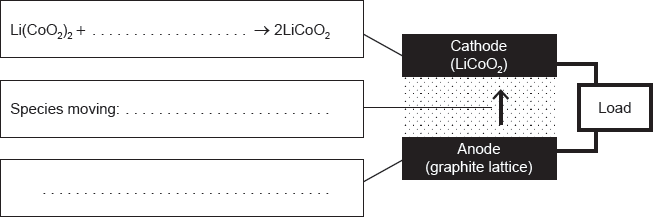| Date | November 2019 | Marks available | 1 | Reference code | 19N.3.hl.TZ0.20 |
| Level | HL | Paper | 3 | Time zone | TZ0 |
| Command term | Suggest | Question number | 20 | Adapted from | N/A |
Question
A proton-exchange membrane (PEM) fuel cell uses pure hydrogen gas as the fuel and a proton exchange membrane as the electrolyte.
A dye-sensitized solar cell (DSSC) uses light energy to produce electricity.
Deduce the half-equations for the reactions occurring at the electrodes.
Anode (negative electrode):
Cathode (positive electrode):
Calculate the cell potential, Eθ, in V, using section 24 of the data booklet.
Suggest how PEM fuel cells can be used to produce a larger voltage than that calculated in (b)(i).
Suggest an advantage of the PEM fuel cell over the lead-acid battery for use in cars.
Outline the functions of the dye, TiO2 and the electrolyte in the operation of the DSSC.
Dye:
TiO2:
Electrolyte:
Suggest an advantage of the DSSC over silicon-based photovoltaic cells.
Markscheme
Anode (negative electrode):
H2 (g) → 2H+ (aq) + 2e− ✔
Cathode (positive electrode):
O2 (g) + 4H+ (aq) + 4e− → 2H2O (l) ✔
NOTE: Accept any correct integer or fractional coefficients. Award [1 max] for M1 and M2 if correct half-equations are given at the wrong electrodes OR if incorrect reversed half-equations are given at the correct electrodes.
(+)1.23 «V» ✔
NOTE: Do not accept “-1.23 «V»”.
connect several fuel cells in series
OR
increase pressure/concentration of reactant/hydrogen/oxygen ✔
NOTE: Do not accept changes in [H+]/pH as they do not affect cell potential in this case.
Do not accept reference to quantity for “concentration”.
liquid in cell is less/not corrosive
OR
does not contain lead/toxic chemicals
OR
larger energy density/charge capacity/current per unit mass
OR
does not have to be charged prior to use / is always ready for use «as long as fuel is available» ✔
Dye:
absorbs photons/light
OR
releases electrons ✔
TiO2:
conducts current/electricity
OR
semiconductor ✔
Electrolyte:
reduces/regenerates «the oxidized» dye ✔
Any one of:
cheaper/ease of manufacture
OR
plentiful and renewable resources «to construct DSSC cells» ✔
use light of lower energy/lower frequency/longer wavelength
OR
use of nanoparticles provides large surface area for exposure to sunlight/sun/light
OR
can absorb better under cloudy conditions ✔
operate at lower «internal» temperatures
OR
better at radiating heat away «since constructed with thin front layer of conductive plastic compared to glass box in photovoltaic cells» ✔
better conductivity ✔
more flexible/durable ✔
NOTE: Accept “lower mass/lighter «so greater flexibility to integrate into windows etc.»” OR “greater power-conversion efficiency «with latest DSSC models»”.



